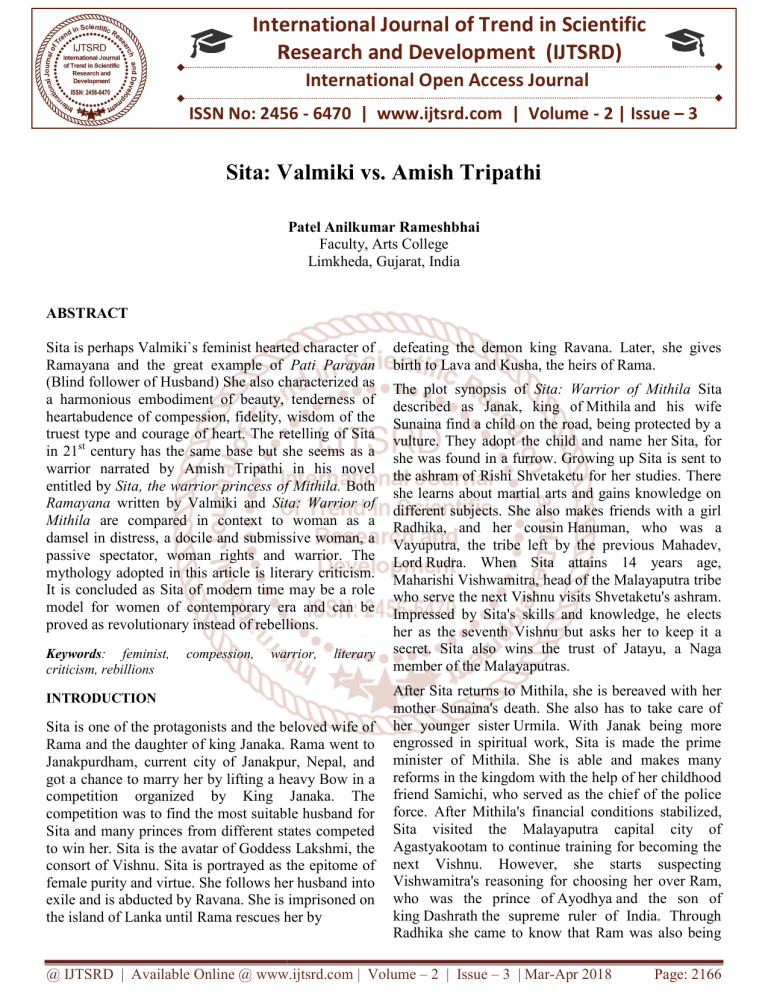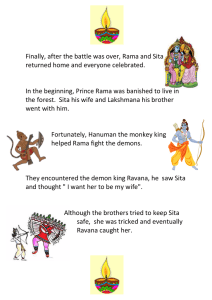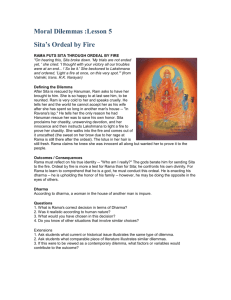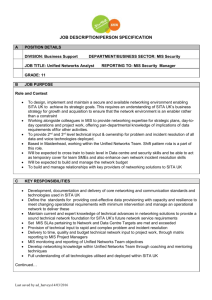
International Journal of Trend in Scientific Research and Development (IJTSRD) International Open Access Journal ISSN No: 2456 - 6470 | www.ijtsrd.com | Volume - 2 | Issue – 3 Sita: Valmiki vs. Amish Tripathi Patel Anilkumar Rameshbhai Faculty, Arts College Limkheda, Gujarat, India ABSTRACT Sita is perhaps Valmiki`s feminist hearted character of Ramayana and the great example of Pati Parayan (Blind follower of Husband) She also characterized as a harmonious embodiment of beauty, tenderness of heartabudence of compession, fidelity, wisdom of the truest type and courage of heart. The retelling of Sita in 21st century has the same base but she seems as a warrior narrated arrated by Amish Tripathi in his novel entitled by Sita, the warrior princess of Mithila. Both Ramayana written by Valmiki and Sita: Warrior of Mithila are compared in context to woman as a damsel in distress, a docile and submissive woman, a passive spectator, ator, woman rights and warrior. The mythology adopted in this article is literary criticism. It is concluded as Sita of modern time may be a role model for women of contemporary era and can be proved as revolutionary instead of rebellions. Keywords: feminist, criticism, rebillions compession, warrior, literary INTRODUCTION Sita is one of the protagonists and the beloved wife of Rama and the daughter of king Janaka. Rama went to Janakpurdham, current city of Janakpur, Nepal, and got a chance to marry her by lifting a heavy Bow in a competition organized by King Janaka. The competition was to find the most suitable husband for Sita and many princes from different states competed to win her. Sita is the avatar of Goddess Lakshmi, the consort of Vishnu. Sita ita is portrayed as the epitome of female purity and virtue. She follows her husband into exile and is abducted by Ravana. She is imprisoned on the island of Lanka until Rama rescues her by defeating the demon king Ravana. Later, she gives birth to Lavaa and Kusha, the heirs of Rama. The plot synopsis of Sita: Warrior of Mithila Sita described as Janak, king of Mithila and his wife Sunaina find a child on the road, being protected by a vulture. They adopt the child and name her Sita, for she was found in a furrow. Growing up Sita is sent to the ashram of Rishi Shvetaketu for her studies. There she learns about martial arts and gains knowledge on different subjects. She also makes friends with a girl Radhika, and her cousin Hanuman, who was a Vayuputra, the tribe left by the previous Mahadev, Lord Rudra. When Sita attains 14 years age, Maharishi Vishwamitra, head of the Malayaputra tribe who serve the next Vishnu visits Shvetaketu's ashram. Impressed by Sita's skills and knowledge, he elects her as the seventh venth Vishnu but asks her to keep it a secret. Sita also wins the trust of Jatayu, a Naga member of the Malayaputras. After Sita returns to Mithila, she is bereaved with her mother Sunaina's death. She also has to take care of her younger sister Urmila. With W Janak being more engrossed in spiritual work, Sita is made the prime minister of Mithila. She is able and makes many reforms in the kingdom with the help of her childhood friend Samichi, who served as the chief of the police force. After Mithila's financial ncial conditions stabilized, Sita visited the Malayaputra capital city of Agastyakootam to continue training for becoming the next Vishnu. However, she starts suspecting Vishwamitra's reasoning for choosing her over Ram, who was the prince of Ayodhya and the son of king Dashrath the supreme ruler of India. Through Radhika she came to know that Ram was also being @ IJTSRD | Available Online @ www.ijtsrd.com | Volume – 2 | Issue – 3 | Mar-Apr Apr 2018 Page: 2166 International Journal of Trend in Scientific Research and Development (IJTSRD) ISSN: 2456-6470 considered for becoming the next Vishnu by his mentor Rishi Vashistha an old friend of Vishwamitra. Sita plans a marriage alliance with Ram through a Swayamvar, but is enraged to learn that the Lankan king Raavan and his brother Kumbhakaran have also come there. She manipulates the situation with Vishwamitra so that Ram's name is announced as the first suitor. Ram wins the Swayamvar and marries Sita, while his brother Lakshman marries Urmila. The next day, Raavan besieges Mithila with 10,000 soldiers, and Ram is forced to use the biological weapon Asurastra by Viswamitra, even though its usage is forbidden by Lord Rudra. The Lankan army is defeated and Raavan escapes on his helicopter, Pushpak Viman. Ram returns to Ayodhya and decides to take a 14-year exile as punishment for breaking Lord Rudra's rule about the weapon. Sita holds a grudge against Viswamitra for forcing Ram to use the weapon and never speaks to him. Together with Lakshman she joins Ram on the exile, but enlists help from Jatayu and his men, to protect Ram and supply the trio with the anti-ageing drink, Somras. Numerous incidents take place during their exile and thirteen years pass by. One day, with Ram and Lakshman out hunting, the camp is attacked by Raavan and his soldiers. Sita rushes to help a wounded Jatayu but loses the fight against so many soldiers. She is kidnapped and carried unconscious into the Pushpak Viman. Once she regains conscious she attempts killing Raavan in the vehicle but is stopped by a woman drawing a blade to her throat. With Raavan being alerted, Sita turns back and is startled to see that it is Samichi. Thus, Amish Tripathi`s Sita and Valmiki`s Sita are no doubt have different ages of time but some of the characteristics are same and can be evaluated in sense of compare and contrast between the two through literary criticism. OBJECTIVES 1. To examine similarities in Ramayana and Sita: Warrior of Mithila in context to Sita`s character. 2. To examine de-similarities in Ramayana and Sita: Warrior of Mithila in context to Sita`s character 3. To identify the message given to the society by both the texts through the character of Sita DISCUSSION Story retelling is an art in literature. The readers are also curious to accept such kind of versions. The mythological themes are very popular in India for story retailing. The story version from text to film, text to TV serial text to text in poetic, novel and other popular forms. In this study, Sita narrated by Valmiki in Ramayana and Sita narrated by Amish Tripathi in Sita: Warrior of Mithila are compared in some extents. This study is based on secondary sources and primary sources. The main primary source is a text Ramayana written by Valmiki and edited -translated by Manmatha Nath Datta(1891) and Sita: Warrior of Mithila written by Amish Tripathi and published by Westland Press,UK2017). Ramayana is a story of Lord Rama,Sita and Ravana where Lord Rama enters as a character from very beginning of the story written by Valmiki where as Amish Tripathi`s Rama enters in the story as a character in the last one third of the book entitled by Sita: Warrior of Mithila. For many immigrant women, the name, Sita, conjures up an image of a chaste pati vrata woman, the ideal woman. Some see her as victimized and oppressed who obeyed her husband's commands, followed him, remained faithful to him, served her in-laws or yielded to parental authority, generally did her duty whether she wanted to or not. Yet, there are others who see a more liberated Sita, a cherished wife of Ram. She was outspoken, had the freedom to express herself, said what she wanted to in order to get her way, fell for the temptation of the golden deer, spoke harsh words, repented for it, loved her husband, was faithful to him, served her family, did not get seduced by the glamour and material objects in Ravana's palace, faced an angry and suspicious husband, tried to appease him, reconciled her marriage, later accepted her separation, raised well balanced children as a single mother and then moved on. Sita revealed her greatness wherever she was placed. When we call these characters great, what exactly do we mean? Do we mean that their lives were pure, so free from human weaknesses and so richly endowed with subtle protective forces that no complicated situations could arise to upset them. Far from it. The greatness of most of them consisted rather in their strength that truth, sincerity, self sacrifice and other virtues gave. If the test of greatness is the capacity to remain true to one's principles in spite of terrors and temptations, Sita's greatness was undoubtedly more pronounced; for she portrayed a greater power of endurance that any other character, except possibly Rama. It is not that Sita did not cry or complain, In Ramayan, I saw, that in the case of almost every great woman, the initial stroke of calamity from outside or the surging up of greed from @ IJTSRD | Available Online @ www.ijtsrd.com | Volume – 2 | Issue – 3 | Mar-Apr 2018 Page: 2167 International Journal of Trend in Scientific Research and Development (IJTSRD) ISSN: 2456-6470 within, did as a matter of fact produce the normal human reaction of feeling desperate or of being tried. But as the first effects subsided, every woman regained her balance, very slowly in some cases, but steadily, until at last she reached the highest values of life that mankind or womankind can ever manifest under similar circumstances. In Sita: Warrior of Mithila, Rama and Bharat are shown to have conflicting view on masculine and feminine system of the society. Bharat takes a liberal view of life in the novel. While masculine way of life stems crime and brings order and security; feminine way of life brings freedom, creativity, inventions and a sense of well being. The novel gives the message that facing several serious issues because of the feminine way of governance. By giving too much freedom to the citizen, the crime rate had increased to manifold it has brought in disparity in the distribution of wealth and has weakened the unity of the people. The author also focuses on woman empowerment in this novel. Most of the female characters believe that they are also competent to carry all the responsibilities which males are carrying in the society. Sita is shown as to be a warrior rather than a damsel in distress. Thus, entire plot of Ramayana is changed by the author in this novel. Equality, caste system and agitations are also a part of the novel The new horizons of technological use and science is also narrated in the novel. It is also studied that Amish TRPATHI`S Sita seems physically as well as mentally strong. It can be said by quoting the following paragraph. She was almost as tall as Ram. Lean. Muscular. Wheat-complexioned. Her round face a shade lighter than the rest of her body. She had high cheekbones and a sharp, small nose. Her lips were neither thin nor full. Her wide-set eyes were neither small nor large; strong brows were arched in a perfect curve above creaseless eyelids. Her straight, jet-black hair was braided and tied in a neat bun. As always. (SWM 211) Sita of Valmiki in Ramayana, is a strong and powerful woman who didn’t shy away from taking matters into her own hands, a keen to our impression of the modern woman. She fought for and did what she thought was right, what she thought was Dharma. Where as in Sita: Warrior of Mithila,the main character of Sita reflects on struggle between good and evil including woman`s rights. Sita of Amish Tripathi in the novel is different from the Sita narrated by Maharshi Valmiki in Ramayana in terms of role model of modern society of India. Sita,a character of Ramayan is a symbol of love,affections,blind follower of hubband,obedient daughter,ideal family relative to all the members of family. But it is difficult to manage emotions in modern society by any woman like Sita of Valmiki Ramayana. Young Sita becomes able to pick up bow of Lord Shiva belongs to Janaka which was unique and difficult to lift for bold and energetic male, even. Janaka also had a proud on Sita as a daughter as narrated in Ramayana, where as In Sita: Warrior of Mithila,Sita is also a brave girl who becomes able to be a Prime Minister. Sita,in Ramayana is a daughter of land where as Sita of Sita: Warrior of Mithila is a daughter of road(because a Sunaina got Sita on the road).So that,she is also a daughter of land. It is also examined in this study that the idea of Sita swayamvar phenomena seems same in both the writings. Amish Tripathi`s Sita proves more intelligent in this case of swayamvar than Valmiki`s Sita. Some of the female characteristics are same in both the writings like; commitment It is also examined during the study that sense of protection of the people to whom you have love and affection is exhibited as same in Valmiki`s Sita and Amish `s Sita. The status of Goddess to Sita in both the writings seems similar which is given by the people who love Sita as a warrior and Sita who became role model for other women in ancient times. Sita is one of the major character of Ramayana written by Valmiki whereas Sita of Amish Tripathi is in the centre of the novel. Ramayana word it self reflects on importance of Lord Rama in Valmiki`s Ramayana.It cannot be said as Sitayana but in case of Amish Tripathi`s Sita,she is the hero of novel and can be said as female-centric novel which has solution of problems related to modern society. Thus, some of the similarities are found between two characters of Sita. In other words,it can be said that Sita of Amish Tripathi is closely aligned with Sita of Ramayana written by Valmiki. Some of the dissimilarities are also studied during examining the two characters named as Sita in both the writings and some of are discussed in the following manner. Sita of Ramayana is tender and has strong will power where as Sita of Amish Tripathi is strong woman of @ IJTSRD | Available Online @ www.ijtsrd.com | Volume – 2 | Issue – 3 | Mar-Apr 2018 Page: 2168 International Journal of Trend in Scientific Research and Development (IJTSRD) ISSN: 2456-6470 modern times. Feminist essence in Ramayana is less in comparison to Amish Tripathi`s novel. Sita of Ramayana and Amish Tripathi has different ways to face challenges in life. Feminine power is narrated in the novel where as feminine power in Ramayana has different dimension. So that feminine power in both the characters has different dimensions and results. Sita of Valmiki is not only a devoted wife of Lord Rama but courageous woman where as Sita of Amish Tripathi seems as a warrior and princess.In one interview, Amish Trpathi told; “Sita was not just an obedient and humble wife; she was a warrior. I was surprised to know that many people do not even know that she was the adopted daughter of King Janak. The feeling that I have got after interacting with so many people is that although people seem aware of the Ramayana, there is very little knowledge about the story of Sita,”(Hindustan Times,2017) trouble. But Amish’s Sita is just the opposite of the traditional and conventional Sita. It is true that she needs Ram in order to rescue her being captured unawares by Raavan. But in the very first few pages of the novel, we come to know of her fighting skills as a warrior which becomes her distinctive nature. To conclude, both the writings are good gift to the society. Both have good social message. Some dissimilirariries are noted but they have also unique messages to the modern society. Amish Tripathi`s Story retelling through Sita: Warrior of Mithila is classic example by maintaining alignment of Sita`s character of Ramayana.Amish Tripathi has successfully combined the need for woman empowerment through mythological literature. It can also be concluded that The Sita we all can look up to She is the creator, She is the destroyer, She is the Vishnu.She the shaper of destinies, not just her own but of those around her and her tribes. She is the most brilliant warrior, a strategist apart from being a fine statesman and a true leader. Amish Trpathi`s Sita can accelerate woman empowerment movement in the society and also can be helpful to minimize evils from the society. The present technological era has changed perceptions of woman empowerment and ideology on honored womanhood. Amish Tripathi`s Sita seems foot stepping with the modern time and understands the Work Cited need of time to meet the challenges of life and1. tackling the women related issues in such kind of 1. Ralph T. H. Griffith, The Ramayan of Valmiki, male dominated society. Trübner & Co,London 1874, pp-443 The core message from Valmiki`s Ramayana conveys 2. S.Lavanya,Sita-The Born Vishnu in Amish Tripathi`s Sita: Warrior of Mithila Research that good deeds are means to reach a higher plane and Journal of English Language and Literature, likewise bad deeds lead to destruction and doom. It is Vol.5.Issue 4. 2017 pp-1-7 bare fact that each one is responsible for his/her acts, 3. Manmatha Nath Datta,The Ramayana,Dev good and bad and will have to face consequences It is Press,Kolkata,1891 p-322 also fact that Sita `s character shows that human 4. Mandakranta Bose,The Ramayana sorrow is inevitable and affects all, whatever may be Revisited,Oxford University Press,2004 pp-211one`s teparament, scholarship, lineage, etc. whereas 213 the message from Sita: Warrior of Mithila is that modern woman can be also a champion archor,an 5. Amish Tripathi,Sita: Warrior of Mithila,,Westland Publication UK 2017 efficient queen,and an able administrator. CONCLUSION In this novel, Sita is portrayed not as a paradigm of women’s virtue but as a warrior. Amish portrays Sita as an equal partner of Ram.. Sita is portrayed as a woman of wisdom rather than a woman of beauty. In mythological writings, Sita is presented as a paragon of virtue and her chastity is the first thing that is concentrated by any writer. But Sita remains only as a passive participant of the actions and this is what is found in the epic Ramayana. She is not an active participant and she needs Rama to get her out of her Webliography 1. https://www.livemint.com/Sundayapp/XExsCqcM u4vWVwfh8qDUXI/Amishs-Warrior-of-Mithila2. https://www.hindustantimes.com/ @ IJTSRD | Available Online @ www.ijtsrd.com | Volume – 2 | Issue – 3 | Mar-Apr 2018 Page: 2169





